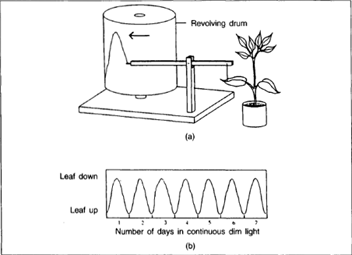Circadian Rhythms
 |
| Figure 30-1 (a) A vety sensitive apparatus designed to record the movements of a leaf. (b) Graph showing the diurnal rhythm of leaf movements under constant light conditions. |
Because such plant movements occur at approximately the same time every day, and because they appear to be based on a twenty-four hour day, they are called circadian rhythms. They are said to be based on “biological clocks.” The French investigator Jean Jacques de Mairan noted the diurnal movements of bean plants in 1729, observing that the movements occurred in the same rhythm when the plants were kept in a constant environment. Similar , responses occur in other flowering plants. The flowers of some plants open at the approach of dusk; the flowers of others, at the approach of light. In fact, the flowers of different species open at various times throughout the night and day. Carolus Linnaeus recognized this fact. He constructed a circular garden having pie-shaped plantings of species whose flowers opened at differing times. By careful arrangement, he was able to devise a “floral” clock that indicated the time of day by which flowers were opened or which leaves were folded upward.
When plants are placed in an environment where it is dark during the day and light during the night, they reverse their responses. The leaves open during the new hours of illumination and assume the sleeping position during the new hours of darkness. In contrast with the observations regarding keeping plants in continuous light (that is, that external factors do not appear to influence plant responses), these observations seem to indicate that external factors such as light do influence plant responses.
The rate of a chemical reaction increases when temperature increases and decreases when temperature decreases. If plant rhythms of behavior are related to chemical events, they should thus also vary with change of temperature. In fact, the type and timing of plant responses are unaffected by temperature changes; the magnitude of such responses, however, is affected as anticipated.
A number of other features of plant life have been observed to demonstrate circadian rhythm. Amontgh ese are the rate of cell division and the rate of photosynthesis; both are maximized at approximately the same time every day regardless of external conditions. Likewise, certain flowers produce nectar at a certain time of day-the same time of day that bees, with their own biological clocks, visit the flowers. The causes of these respective behaviors lie within the organisms.




